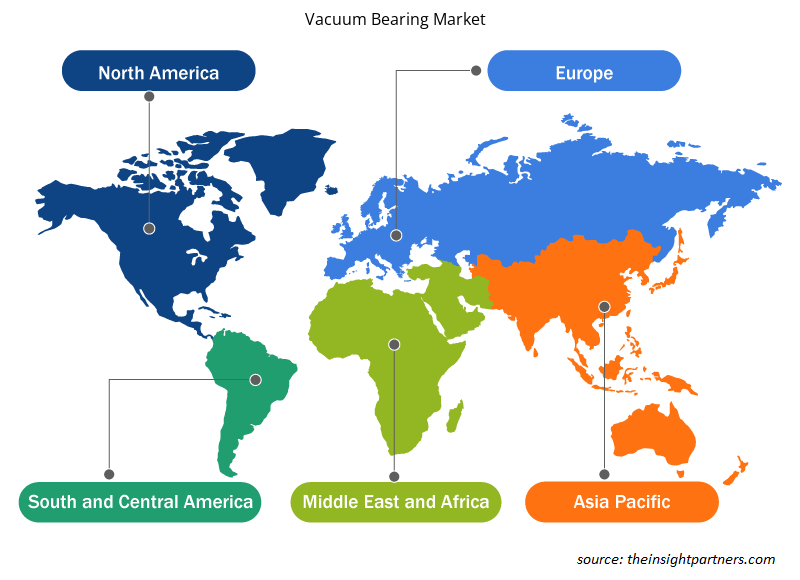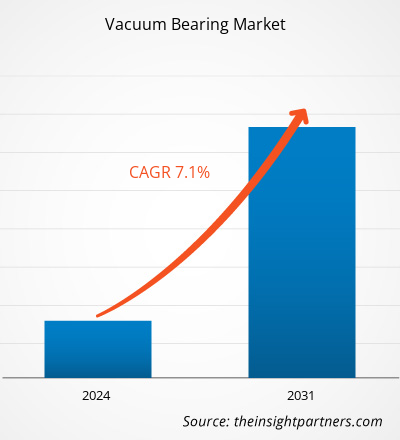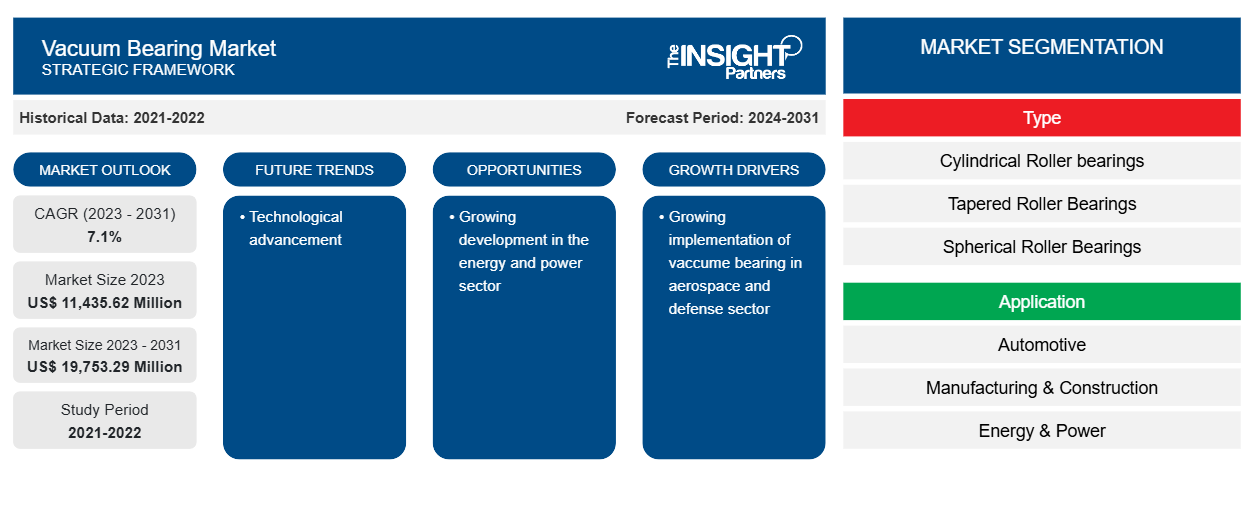Si prevede che la dimensione del mercato dei cuscinetti sotto vuoto raggiungerà i 19.753,29 milioni di dollari entro il 2031, rispetto agli 11.435,62 milioni di dollari del 2023. Si prevede che il mercato registrerà un CAGR del 7,1% nel periodo 2023-2031. È probabile che lo sviluppo crescente nel settore energetico ed elettrico rimanga una tendenza chiave nel mercato.
Analisi del mercato dei cuscinetti sotto vuoto
I principali utenti finali del mercato dei cuscinetti sottovuoto includono i settori automobilistico, manifatturiero e delle costruzioni, aerospaziale e della difesa, energetico e minerario. I cuscinetti sono uno dei componenti più importanti delle parti delle auto. I cuscinetti sono utilizzati per supportare attività a vari livelli, dallo sterzo alla trasmissione alle ruote. Per saperne di più sull'uso dei cuscinetti nel settore automobilistico, leggi questo blog. Una delle principali attività che utilizza molti cuscinetti è il settore automobilistico. I cuscinetti sono impiegati in applicazioni aerospaziali come montanti del carrello di atterraggio degli aerei o ammortizzatori, per prevenire danni da calore e crepe della scala sulla superficie della barra del montante. I produttori di cuscinetti sottovuoto includono HepcoMotion; NSK Ltd; SKF (cuscinetti Kaydon); UNASIS; Bunting bearings, llc; JTEKT Europe Bearings BV Il progresso nella tecnologia dei cuscinetti sta rafforzando la domanda di cuscinetti sottovuoto.
Panoramica del mercato dei cuscinetti sotto vuoto
I principali stakeholder nell'ecosistema del mercato globale dei cuscinetti sottovuoto includono fornitori di materie prime, produttori di cuscinetti sottovuoto e utenti finali. Il fornitore di materie prime è l'interlocutore cruciale nell'ecosistema del mercato dei cuscinetti sottovuoto. Le principali materie prime sono silicio, acciaio inossidabile, ibrido, altri materiali utilizzati principalmente per la fabbricazione dei cuscinetti sottovuoto. I principali fornitori di materie prime includono ASTM International, National Bearings, Kineco Limited, Morgan Advanced Materials, ecc. ASTM International, che è un fornitore di materie prime per cuscinetti, ha annunciato sette nuovi progetti sponsorizzati Research to Standards (R2S) per assistere l'Additive Manufacturing Center of Excellence (AM CoE) di ASTM e il suo obiettivo di accelerare la standardizzazione AM e l'adozione del settore. Di conseguenza, le maggiori attività dei fornitori di materie prime stanno migliorando la produzione di cuscinetti sottovuoto, alimentando la crescita del mercato.
Personalizza questo report in base alle tue esigenze
Riceverai la personalizzazione gratuita di qualsiasi report, comprese parti di questo report, o analisi a livello nazionale, pacchetto dati Excel, oltre a usufruire di grandi offerte e sconti per start-up e università
-
Scopri le principali tendenze di mercato in questo rapporto.Questo campione GRATUITO includerà analisi di dati che spaziano dalle tendenze di mercato alle stime e alle previsioni.
Driver e opportunità del mercato dei cuscinetti sotto vuoto
Crescente implementazione di cuscinetti sotto vuoto nel settore aerospaziale e della difesa per favorire il mercato
Nel settore aerospaziale e della difesa, i cuscinetti sottovuoto sono utilizzati in tutti gli aeromobili, compresi gli aeromobili a fusoliera stretta, gli aeromobili a fusoliera larga, i cargo e i jet. L'uso di base di un cuscinetto sottovuoto in un aeromobile è quello di ridurre la forza assiale e radiale applicata agli alberi. I cuscinetti sottovuoto aerospaziali consentono anche il semplice movimento di sedili, porte e parti dei sistemi di gestione del motore e dei sistemi di controllo del volo senza alcun guasto. Si prevede che il crescente sviluppo nel settore aerospaziale e della difesa guiderà l'applicazione dei cuscinetti sottovuoto a livello globale.
Sviluppo crescente nel settore energetico e elettrico
Praticamente tutte le forme di generazione di energia, come carbone, solare, idroelettrica, nucleare o gas, dipendono principalmente da una dinamo a turbina rotante per trasformare il potenziale meccanico del vento, del vapore o dell'acqua in energia elettrica utilizzabile . Pertanto, i prodotti con cuscinetti ad aria hanno numerose e consequenziali applicazioni alla tecnologia di generazione di energia, riducendo l'efficienza ed eliminando costosi tempi di fermo per le tecnologie utilizzate e quelle attualmente in fase di sviluppo. La crescente domanda di energia sta spingendo il governo a concentrarsi sugli investimenti nel settore energetico ed elettrico per soddisfare i crescenti requisiti che stanno simultaneamente guidando la crescita del mercato dei cuscinetti a vuoto.
Analisi della segmentazione del rapporto di mercato dei cuscinetti sotto vuoto
I segmenti chiave che hanno contribuito alla derivazione dell'analisi di mercato dei cuscinetti sotto vuoto sono tipologia, applicazione, materiale.
- In base al tipo, il mercato dei cuscinetti sotto vuoto è suddiviso in cuscinetti a rulli cilindrici, cuscinetti a rulli conici, cuscinetti a rulli sferici, cuscinetti a rulli assiali e cuscinetti a rulli ad aghi. Il segmento dei cuscinetti a rulli cilindrici ha detenuto una quota di mercato maggiore nel 2023.
- In base all'applicazione, il mercato dei cuscinetti a vuoto è suddiviso in automotive, produzione e costruzione, energia e potenza, estrazione mineraria, aerospaziale e difesa e altri. Il segmento energia e potenza ha detenuto una quota di mercato maggiore nel 2023.
- In base al materiale, il mercato dei cuscinetti a vuoto è suddiviso in silicio, acciaio inossidabile, ibrido e altri. Il segmento dell'acciaio inossidabile ha detenuto una quota di mercato maggiore nel 2023.
Analisi della quota di mercato dei cuscinetti a vuoto per area geografica
L'ambito geografico del rapporto sul mercato dei cuscinetti sotto vuoto è suddiviso principalmente in cinque regioni: Nord America, Asia Pacifico, Europa, Medio Oriente e Africa, Sud e Centro America.
L'Asia Pacifica è leader del mercato. Gli sforzi del governo nell'area Asia Pacifica, come le iniziative "Make in India" e "Make in China" per migliorare il settore manifatturiero del paese, andrebbero a vantaggio anche dell'industria dei cuscinetti sotto vuoto. Il crescente sviluppo nel settore manifatturiero, minerario e aerospaziale sta guidando la domanda di mercato dei cuscinetti sotto vuoto nella regione Asia Pacifica.
Approfondimenti regionali sul mercato dei cuscinetti sotto vuoto
Le tendenze regionali e i fattori che influenzano il mercato dei cuscinetti a vuoto durante il periodo di previsione sono stati ampiamente spiegati dagli analisti di Insight Partners. Questa sezione discute anche i segmenti e la geografia del mercato dei cuscinetti a vuoto in Nord America, Europa, Asia Pacifico, Medio Oriente e Africa e America meridionale e centrale.

- Ottieni i dati specifici regionali per il mercato dei cuscinetti sotto vuoto
Ambito del rapporto sul mercato dei cuscinetti sotto vuoto
| Attributo del report | Dettagli |
|---|---|
| Dimensioni del mercato nel 2023 | 11.435,62 milioni di dollari USA |
| Dimensioni del mercato entro il 2031 | 19.753,29 milioni di dollari USA |
| CAGR globale (2023-2031) | 7,1% |
| Dati storici | 2021-2022 |
| Periodo di previsione | 2024-2031 |
| Segmenti coperti |
Per tipo
|
| Regioni e Paesi coperti |
America del Nord
|
| Leader di mercato e profili aziendali chiave |
|
Densità degli attori del mercato: comprendere il suo impatto sulle dinamiche aziendali
Il mercato dei cuscinetti sotto vuoto sta crescendo rapidamente, spinto dalla crescente domanda degli utenti finali dovuta a fattori quali l'evoluzione delle preferenze dei consumatori, i progressi tecnologici e una maggiore consapevolezza dei vantaggi del prodotto. Con l'aumento della domanda, le aziende stanno ampliando le loro offerte, innovando per soddisfare le esigenze dei consumatori e capitalizzando sulle tendenze emergenti, il che alimenta ulteriormente la crescita del mercato.
La densità degli operatori di mercato si riferisce alla distribuzione di aziende o società che operano in un particolare mercato o settore. Indica quanti concorrenti (operatori di mercato) sono presenti in un dato spazio di mercato in relazione alle sue dimensioni o al valore di mercato totale.
Le principali aziende che operano nel mercato dei cuscinetti sotto vuoto sono:
- Movimento Hepco
- NSK Ltd.
- Schaeffler Technologies AG & Co. KG
- LA SOCIETÀ TIMKEN
- Cuscinetti Bunting, LLC
- Movimento TPA, LLC
Disclaimer : le aziende elencate sopra non sono classificate secondo un ordine particolare.

- Ottieni una panoramica dei principali attori del mercato dei cuscinetti a vuoto
Notizie e sviluppi recenti sul mercato dei cuscinetti sotto vuoto
Il mercato dei cuscinetti sotto vuoto viene valutato raccogliendo dati qualitativi e quantitativi dopo la ricerca primaria e secondaria, che include importanti pubblicazioni aziendali, dati associativi e database. Di seguito sono elencati alcuni degli sviluppi nel mercato dei cuscinetti sotto vuoto:
- HepcoMotion ha aperto un nuovo Stockholding Factory nei Paesi Bassi. Questo nuovo stabilimento rappresenta un nuovo importante impegno per HepcoMotion e si prevede che accelererà e semplificherà la distribuzione dei prodotti ai clienti UE. (Fonte: HepcoMotion, comunicato stampa, gennaio 2022)
- Schaeffler Technologies AG & Co. KG ha annunciato la sua partnership di 12 anni con Rolls Royce. Con le più recenti tecnologie di produzione e metodi di fabbricazione, Schaeffler dovrebbe fornire supporto a lungo termine a Rolls-Royce. (Fonte: Schaeffler Technologies AG & Co. KG, comunicato stampa, aprile 2022)
Copertura e risultati del rapporto sul mercato dei cuscinetti sotto vuoto
Il rapporto "Dimensioni e previsioni del mercato dei cuscinetti a vuoto (2021-2031)" fornisce un'analisi dettagliata del mercato che copre le seguenti aree:
- Dimensioni e previsioni del mercato dei cuscinetti a vuoto a livello globale, regionale e nazionale per tutti i principali segmenti di mercato coperti dall'ambito
- Tendenze del mercato dei cuscinetti a vuoto e dinamiche di mercato come driver, vincoli e opportunità chiave
- Analisi PEST e SWOT dettagliate
- Analisi di mercato dei cuscinetti a vuoto che copre le principali tendenze di mercato, il quadro globale e regionale, i principali attori, le normative e i recenti sviluppi del mercato
- Analisi del panorama industriale e della concorrenza che copre la concentrazione del mercato, l'analisi della mappa di calore, i principali attori e gli sviluppi recenti per il mercato dei cuscinetti a vuoto
- Profili aziendali dettagliati
- Analisi storica (2 anni), anno base, previsione (7 anni) con CAGR
- Analisi PEST e SWOT
- Valore/volume delle dimensioni del mercato - Globale, Regionale, Nazionale
- Industria e panorama competitivo
- Set di dati Excel
Report recenti
Testimonianze
Motivo dell'acquisto
- Processo decisionale informato
- Comprensione delle dinamiche di mercato
- Analisi competitiva
- Analisi dei clienti
- Previsioni di mercato
- Mitigazione del rischio
- Pianificazione strategica
- Giustificazione degli investimenti
- Identificazione dei mercati emergenti
- Miglioramento delle strategie di marketing
- Aumento dell'efficienza operativa
- Allineamento alle tendenze normative























 Ottieni un campione gratuito per - Mercato dei cuscinetti sotto vuoto
Ottieni un campione gratuito per - Mercato dei cuscinetti sotto vuoto